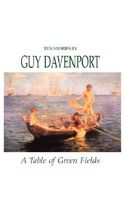- Welcome to FictionDB, Guest
- | My Account
- | Help

A Table of Green Fields: Ten Stories — Guy Davenport

A Table of Green Fields includes ten stories, variously about the painter Henry Scott Tuke, the mathematician James Joseph Sylvester, Kafka, Thoreau, along with some imaginary Frenchmen and Scandinavians, among others. Calculating the infinite in the finite, tracing geometries of desire, placing the obdurate world in an uncustomary light, each of these stories opens out its own world. Without giving up the plot or character of the traditional short story, Guy Davenport's inventions are complex events in which ideas and cultural history are a kind of music to which the characters dance. Despite the fractal, syncopated collage of his narrative style, Davenport's prose is objective, terse, and transparent. A constant theme in this book is the transmission of the past as an imaginative act; hence the title, Falstaff's dying vision of "a table of green fields," probably a mishearing of his recitation of the Twenty-third Psalm, corrected by editors to "he babbled of green fields," a symbol of all fiction, an art that must be exact about the uncertain.
Genres
Click on any of the links above to see more books like this one.
EDITIONS
Sign in to see more editions-
- Nov-1993
- New Directions Publishing Corporation
- Trade Paperback
- ISBN: 081121771X
- ISBN13: 9780811217712

